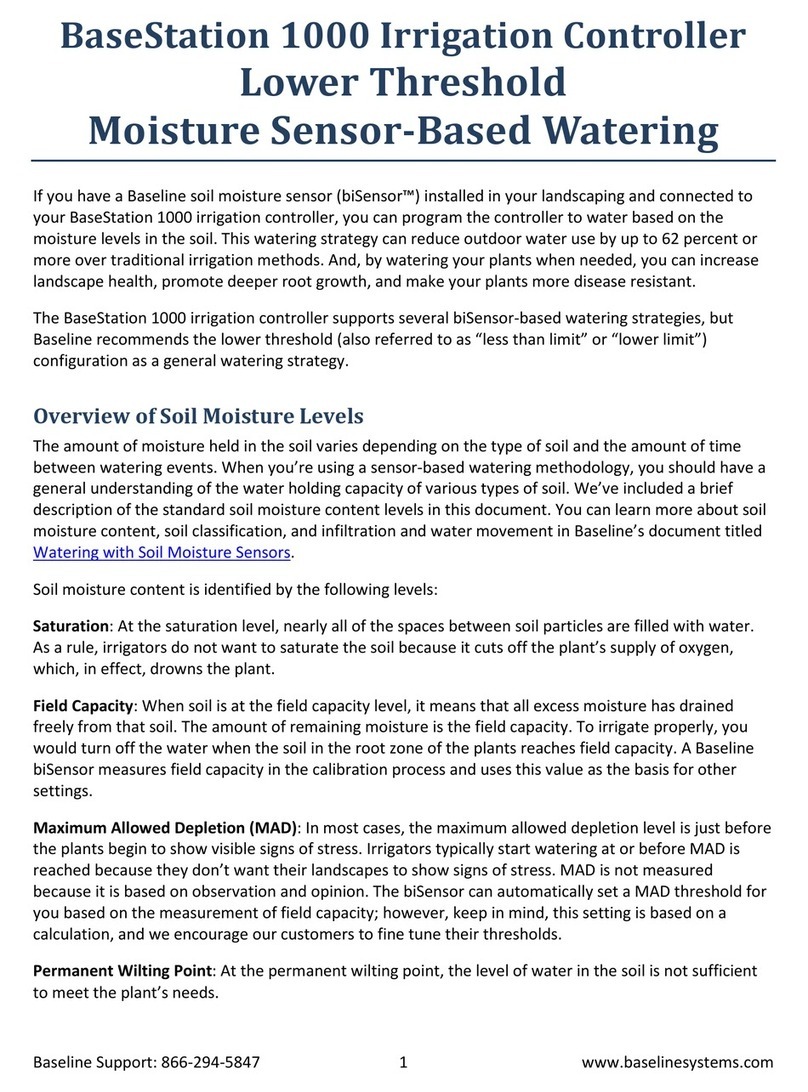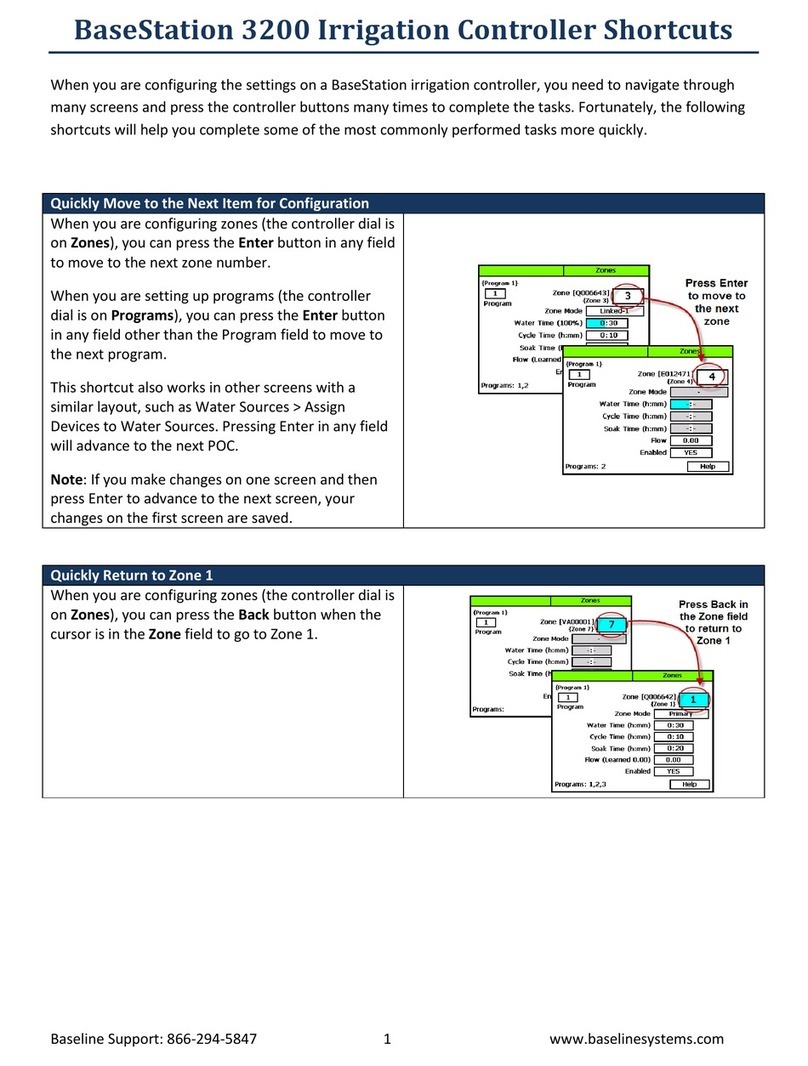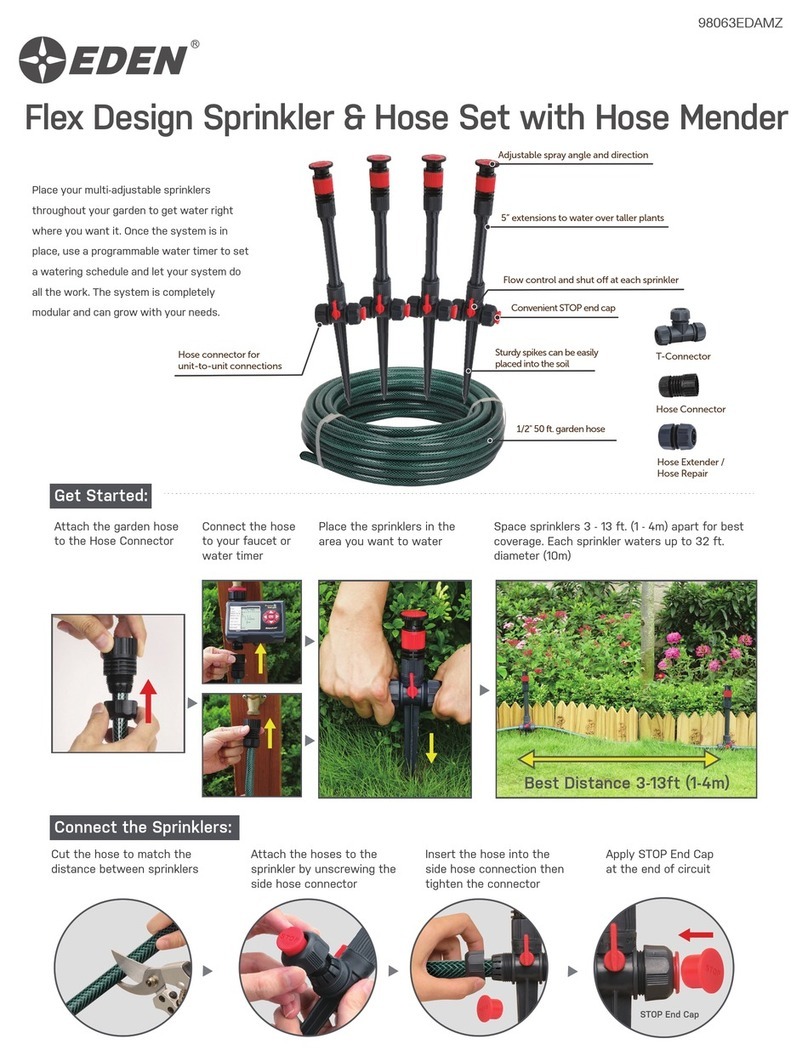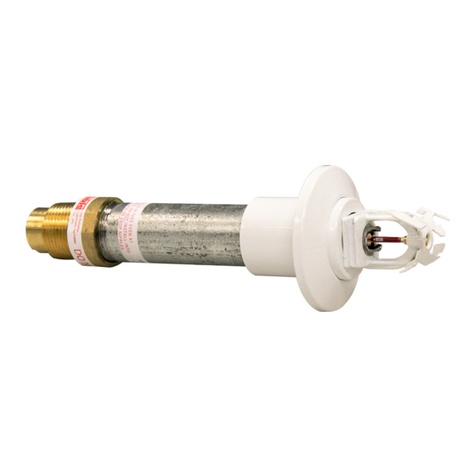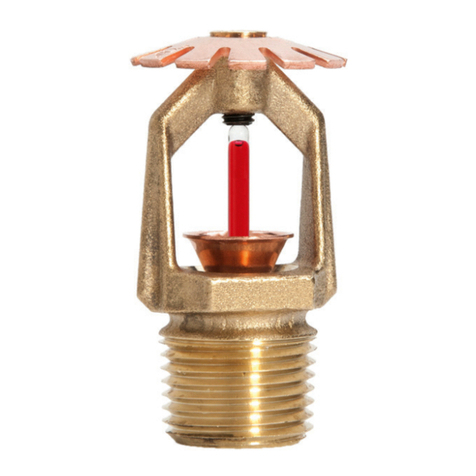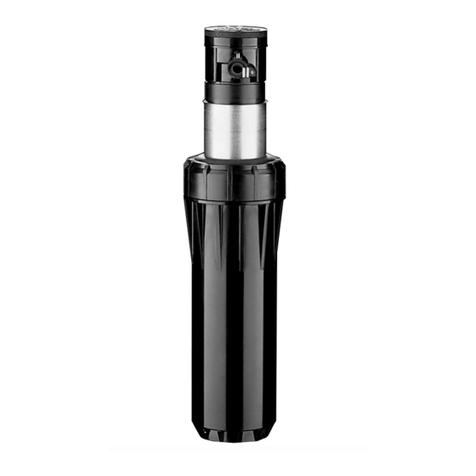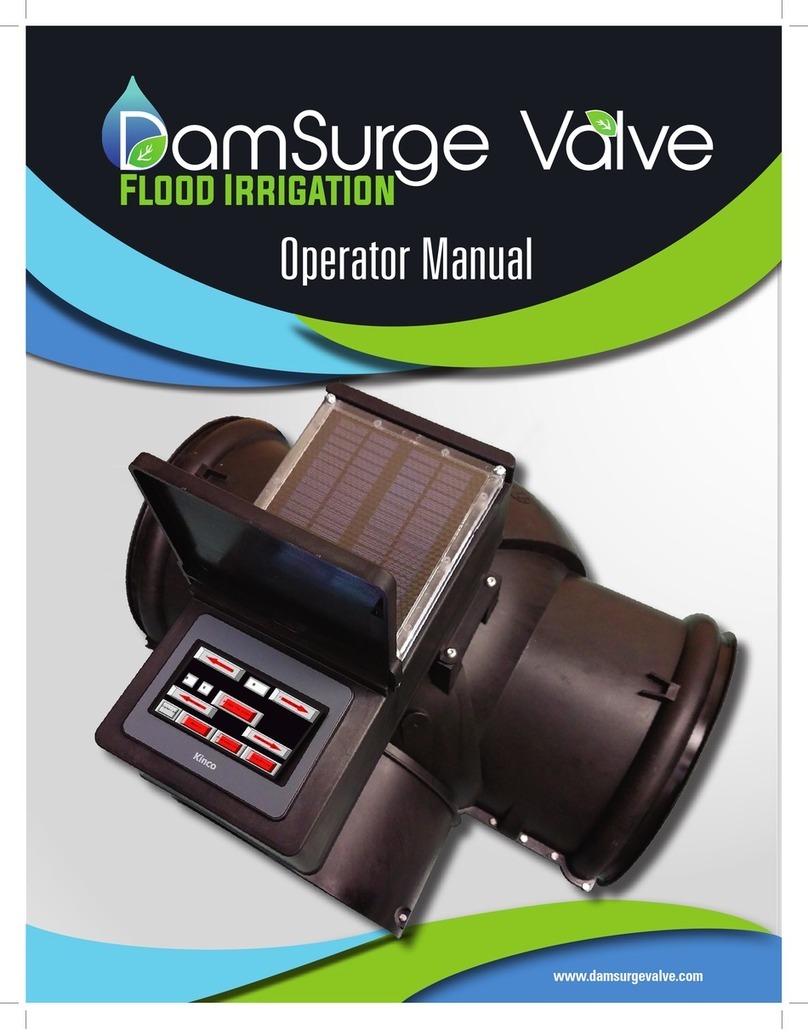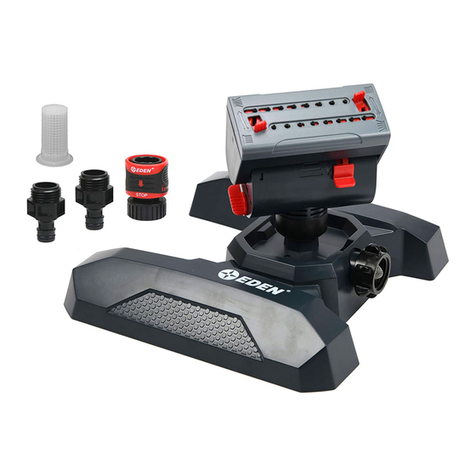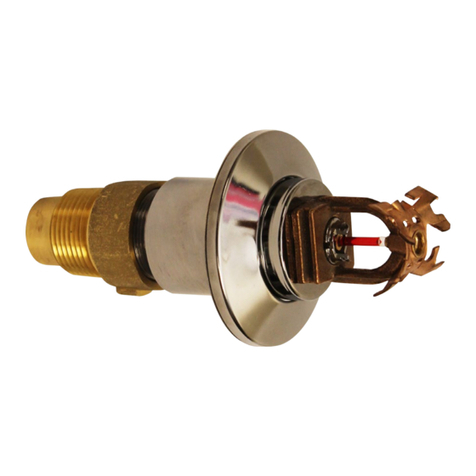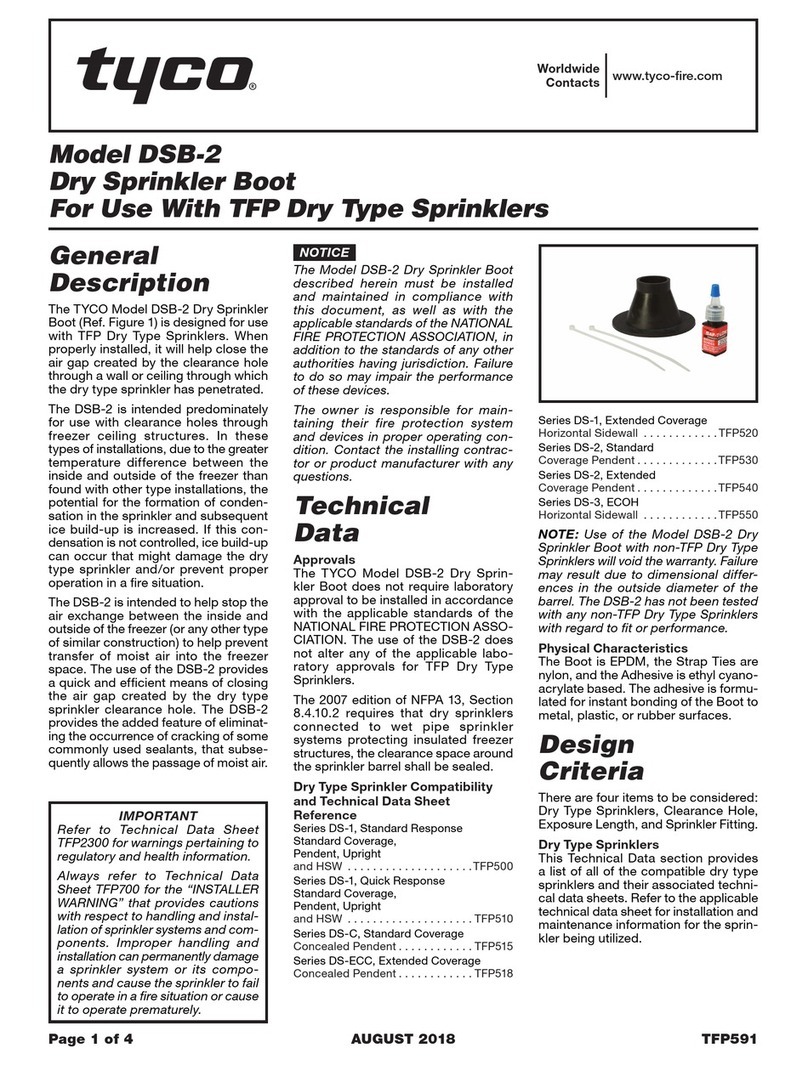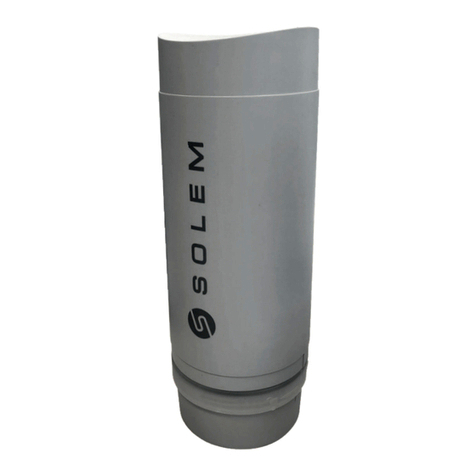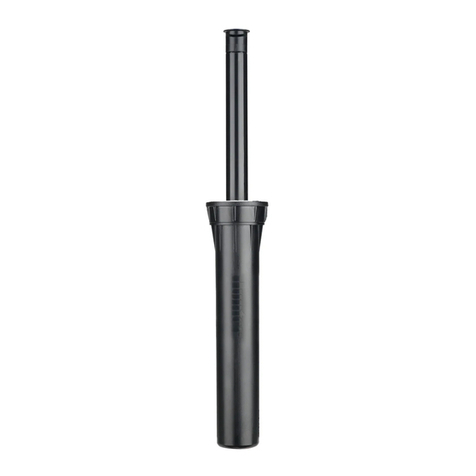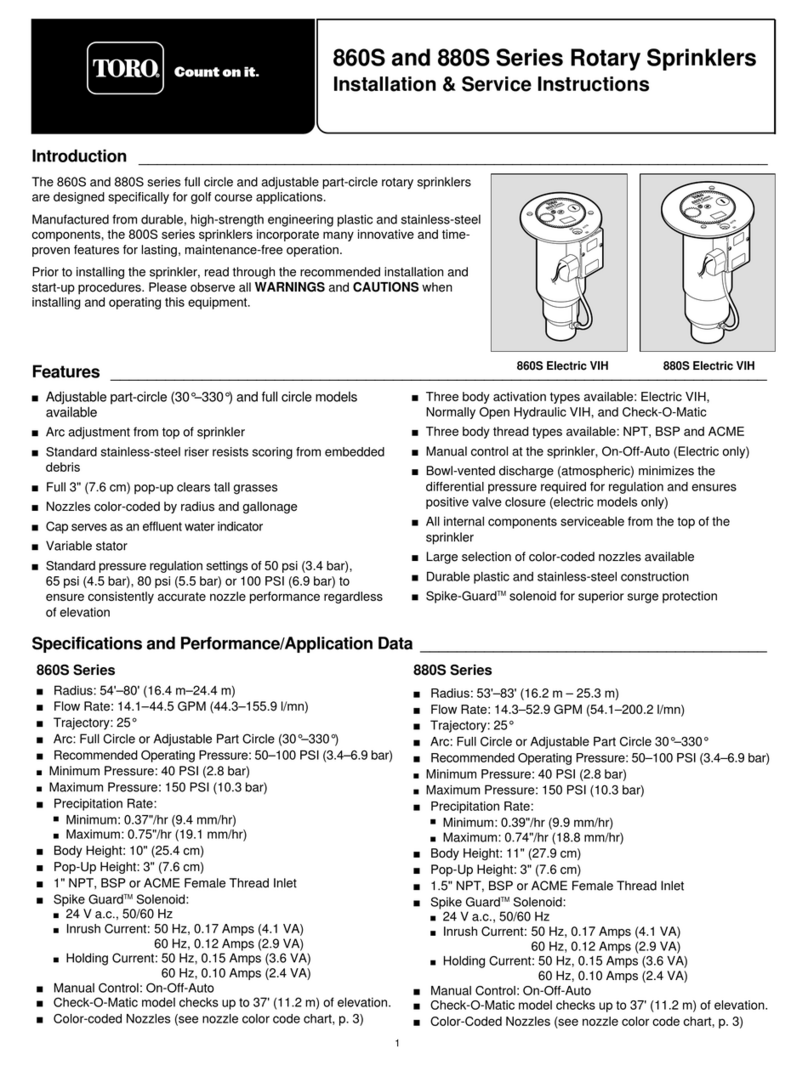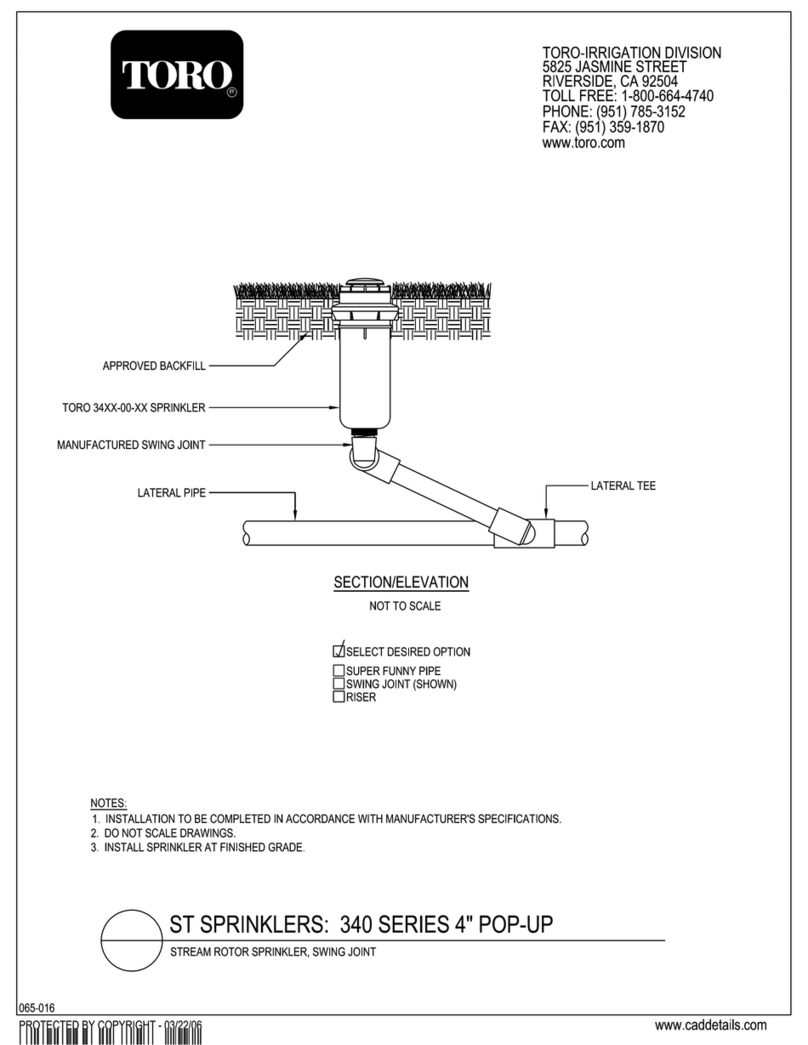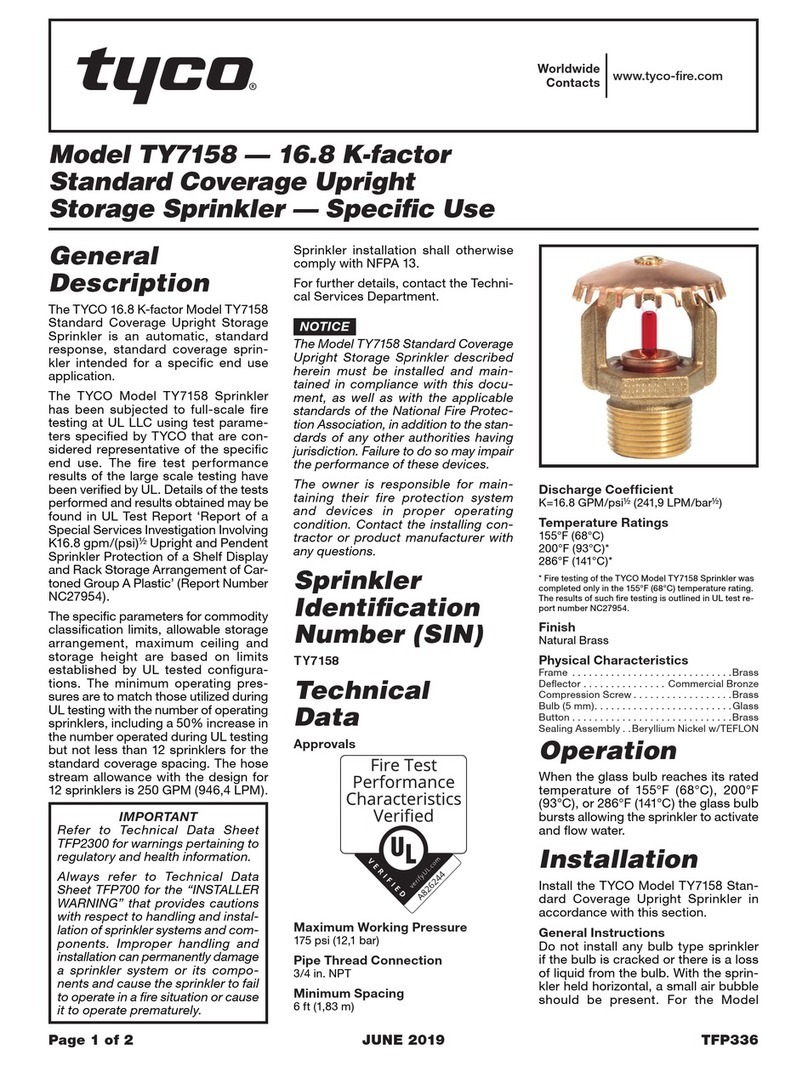Base Line BaseStation 3200 User manual

BaseStation 3200 Irrigation Controller
Upper Threshold
Moisture Sensor-Based Watering
If you have a Baseline soil moisture sensor (biSensor™) installed in your landscaping and connected to
your BaseStation 3200 irrigation controller, you can program the controller to water based on the
moisture levels in the soil. This watering strategy can reduce outdoor water use by up to 62 percent or
more over traditional irrigation methods. And, by watering your plants when needed, you can increase
landscape health, promote deeper root growth, and make your plants more disease resistant.
For areas that have a restricted schedule such as specific watering days or specific use schedules like
sports fields, upper threshold (also referred to as “greater than limit” or “upper limit”) is a popular
watering strategy. With upper threshold, you can choose which day and what time of day to start
watering and the sensor will shut off watering when soil moisture reaches the upper threshold, which is
usually slightly above field capacity.
The upper threshold watering strategy varies the zone water time each time the program runs in order
to apply enough water to raise the moisture level to field capacity. Soak cycles are critical for this mode
because the controller monitors the moisture level as water is applied. At the end of each soak cycle,
the controller determines whether an additional water cycle is needed. After the upper limit has been
reached, the controller will water for an additional 10% of the water time to increase deep watering.
Note: Make sure your program’s runtime is sufficient to raise the moisture content in the soil to field
capacity. You should put down at least ½ - ¾ inch of water each time the controller is allowed to water.
Overview of Soil Moisture Levels
The amount of moisture held in the soil varies depending on the type of soil and the amount of time
between watering events. When you’re using a sensor-based watering methodology, you should have a
general understanding of the water holding capacity of various types of soil. We’ve included a brief
description of the standard soil moisture content levels in this document. You can learn more about soil
moisture content, soil classification, infiltration, and water movement in Baseline’s document titled
Watering with Soil Moisture Sensors.
Soil moisture content is identified by the following levels:
Saturation: At the saturation level, nearly all of the spaces between soil particles are filled with water.
As a rule, irrigators do not want to saturate the soil because it cuts off the plant’s supply of oxygen,
which, in effect, drowns the plant.
Field Capacity: When soil is at the field capacity level, it means that all excess moisture has drained
freely from that soil. The amount of remaining moisture is the field capacity. To irrigate properly, you
would turn off the water when the soil in the root zone of the plants reaches field capacity. A Baseline
biSensor measures field capacity in the calibration process and uses this value as the basis for other
settings.
Baseline Support: 866-294-5847 1 www.baselinesystems.com

Upper Threshold Moisture Sensor-Based Watering
Maximum Allowed Depletion (MAD): In most cases, the maximum allowed depletion level is just before
the plants begin to show visible signs of stress. Irrigators typically start watering at or before MAD is
reached because they don’t want their landscapes to show signs of stress. MAD is not measured
because it is based on observation and opinion. The biSensor can automatically set a MAD threshold for
you based on the measurement of field capacity; however, keep in mind, this setting is based on a
calculation, and we encourage our customers to fine tune their thresholds.
Permanent Wilting Point: At the permanent wilting point, the level of water in the soil is not sufficient
to meet the plant’s needs.
Overview of the Steps for Configuring the Upper Threshold Watering
Strategy
Perform the following steps to configure the controller for upper threshold watering:
Step 1 – Install the biSensor in the landscaping according to the instructions that came with the device.
Step 2 – Set up a primary zone and configure the zone settings.
Step 3 – Create a scheduling group.
Step 4 – Search for and assign the biSensor to the primary zone.
Step 5 – Configure the biSensor and set up the watering strategy.
Step 6 – Set up the start time for the program.
Step 7 – Set up the start days for the program.
Step 8 – Set up the water windows for the program.
Step 9 – Set the controller to run.
Step 1 – Installing the biSensor
The biSensor needs to be placed in the effective root zone of the plant it is monitoring. Usually the
biSensor will be making the irrigation decision for many plants or even multiple zones of plants with
similar water needs, so it should be placed in the effective root zone of a representative plant.
Take note of the serial number of the biSensor that you are installing in the landscape. You will need this
number when you program the controller.
Follow the wiring instructions in the biSensor installation guide to connect the biSensor to the two-wire
path or to the biSensor ports on the controller or on the powered biCoder.
Make sure that you maintain polarity on the wire connections.
Fasten the wiring with wire nuts, and then test communication with the controller before you complete
the installation with waterproof connectors.
Baseline Support: 866-294-5847 2 www.baselinesystems.com

Upper Threshold Moisture Sensor-Based Watering
Step 2 – Setting Up a Primary Zone and Configuring the Zone Settings
After you have defined the area that will be watered by the sensor-based strategy, identify the zones
that water that area. From those zones, select one to be associated with the sensor. Then, in the
controller, designate that zone as the primary zone.
In addition to being the zone that is associated with a sensor, a primary zone is the zone within a
scheduling group that all other linked zones are linked to. Changing the programming on this zone will
adjust the programming on all linked zones, resulting in saved time and consistency.
Note: The primary zones of a program always run first.
Prerequisites
•biCoders have been assigned to zones.
•If you are using soil moisture sensors, they have been installed and detected by the controller.
•You know the number of the zone that waters the area where the sensor is installed.
To assign a primary zone
1. Turn the dial to the Zones position.
2. Verify that the number displayed in the Program field matches the program in which you want to
set up the primary zone. If the zone is enabled in multiple programs and you want to set up the
primary zone in a different program, press the +or –button to change the program number.
Note: A zone can only be a primary zone in one program. The programs that this zone is assigned to
are listed in the lower-left corner of the screen.
3. Press the Next button to move to the Zone field, and then press the +or –button to select the zone
that you want to assign as a primary zone.
4. Press the Next button to move to the Zone Mode field.
5. Press the +or –button until Primary displays in the Zone
Mode field.
Note: If you change the mode of a zone to Primary or
from Primary to another mode, you will potentially affect
the programming of other zones. For example, a primary
zone has 20 linked zones. If you change the mode of the
primary zone to linked or timed, the links to the 20 zones
will be broken.
Baseline Support: 866-294-5847 3 www.baselinesystems.com

Upper Threshold Moisture Sensor-Based Watering
To configure the zone settings
Upper threshold watering starts a watering cycle on each start time for the primary zone and adjusts the
watering time to raise the moisture level back up to the upper limit (field capacity). The controller
increases or decreases the water time, but it never adjusts more than twice your initial water time.
When you set a program to start based on a biSensor reading that is greater than the limit, you need to
set up at least 3 soak cycles with a soak time that is at least twice as long as the cycle time. Soak cycling
breaks the total runtime into shorter water “cycles” with “soak” periods in between to allow time for
water to soak into the soil.
1. Press the Next button to move to the Water Time field.
Set zone water times to apply ½ - ¾ inch of water.
If you want to increase the value in the hours place,
press the +button.
If you want to change the value in the minutes place,
press the Next button, and then press the +or –
button.
Note: When you change the water time setting for a
linked zone, notice that a percentage displays to the
left of the Water Time field. This percentage
compares the new value with the value in the Water Time field for the Primary zone and
establishes a tracking ratio. The ratio will be maintained when changes are made to the primary
zone’s water time.
Tip: Let the controller calculate the cycle time and soak time settings for you. Press the Next button
to move to the minutes placeholder in the Soak Time field, and then press the Back button. The
controller divides the time in the Water Time field by 3. This value is used for the cycle time and the
default soak time is 30 minutes.
2. Press the Next button to move to the Cycle Time field. The cycle time defines the duration of each
watering cycle interspersed with soak times.
Note: You cannot change the cycle time setting for a linked zone.
3. Press the Next button to move to the Soak Time field. The soak time defines the duration of each
soaking cycle interspersed with watering times.
Note: You cannot change the soak time setting for a linked zone.
4. Press the Next button to move to the Flow field. If you know the gallons per minute flow for this
zone, you can press the +or –button to enter it in this field. You can also perform a Learn Flow
operation to update this field. Refer to Learning Flow by Zone in the BaseStation 3200 User Manual.
5. Press the Next button to move to the Enabled field. Press the +or –button to toggle the value in
the field between YES and NO.
Note: If you want to prevent a zone from running, you can temporarily set the Enabled field to NO.
When you want the zone to run again, return to the Zones dial position and change this setting to
YES. This setting disables the zone in all programs.
Baseline Support: 866-294-5847 4 www.baselinesystems.com

Upper Threshold Moisture Sensor-Based Watering
Step 3 – Creating a Scheduling Group
1. Turn the dial to the Zones position.
2. Verify that the number displayed in the Program field in the upper-left corner of the screen matches
the program in which you want to set up the scheduling group. If the zone is enabled in multiple
programs and you want to set up the scheduling group in a different program, press the Next button
to move to the Program field, and then press the +or –button to change the program number.
Note: You can only link a zone to its primary zone within the same program. Linked zones cannot
cross programs.
3. In the Zone field, press the +or –button to select the zone that you want to link.
4. Press the Next button to move to the Zone Mode field.
5. Press the +button to change the entry in the field so it shows Linked-#.
6. To continue linking zones, press the Enter button until the number of the zone that you want to link
displays in the Zone field at the top of the screen.
7. Repeat steps 5 and 6 until you have linked all the zones in the group to the primary zone for that
group.
Step 4 – Assigning the biSensor to the Primary Zone
When you use soil moisture sensors (biSensors) to monitor your zones, you need to assign a biSensor to
a primary zone. If you have not configured any primary zones, you will not be able to complete the
following procedure. Refer to Step 2 in this document.
1. Turn the dial to the Smart Watering position.
2. The Moisture Sensor Assignments option should be highlighted. If it is not highlighted, press the +
or –button to highlight it.
3. Press the Enter button. The Assign Sensors screen
displays.
4. The Search option should be highlighted in the column
on the left. If it is not highlighted, press the +or –
button to highlight Search.
5. Press the Enter button. The system lists the serial
numbers of all biSensors that it finds.
Note: The BaseStation 3200 supports 25 biSensors.
6. Press the +or –button to highlight the serial number of
the biSensor that you want to assign, and then press the Enter button. The serial number moves
from the list on the left to zone address on the right.
Baseline Support: 866-294-5847 5 www.baselinesystems.com

Upper Threshold Moisture Sensor-Based Watering
Step 5 – Configuring the biSensors and Setting Up Watering Strategies
1. Turn the dial to the Smart Watering position.
2. Press the Next button to select Moisture Sensor Setup,
and then press the Enter button. The Sensor Setup screen
displays.
3. If you have more than one biSensor installed and
assigned to a primary zone, verify that the correct
primary zone displays in the Sensor Primary Zone field
(the serial number of the assigned biSensor displays in
the lower-left corner of the screen). If the biSensor that
you want to configure is not displayed in the field, press
the +or –button to select the correct one.
4. Press the Next button to move to the Water Strategy field, and then press the +or –button to
select the Upper Limit water strategy.
5. Press the Next button to move to the Upper Limit field. Press the +or –button to change the
number in the field.
Note: When you choose the upper threshold water strategy, you must set and manage the upper
watering limit. You can have the controller perform an initial calibration cycle to establish the
starting limit value. This calibration cycle will be run on the first start time, two days after the
biSensor installation date. After the initial calibration cycle has been run, you must monitor the
moisture levels and plant health so you can make adjustments as needed.
6. Press the Next button to move to the Limit Adjustment field.
Note: This field is typically used to offset the limit set by a calibration cycle. You can use this
adjustment to make the soil a little wetter or a little drier than the controller set limit. If you think
that you might need to use this field, contact Baseline Support for help.
7. Press the Next button to move to the Calibration Cycle field.
Never – No calibration cycle will be performed
One Time – A single calibration cycle will be performed at the next start time
Monthly – A calibration cycle will be performed each month at the first start time
Note: Calibration cycles require that soak cycles be enabled. When you set these watering
strategies, soak cycles will be automatically enabled.
8. When you have finished making changes, turn the dial to the RUN position.
Note: If for any reason the biSensor becomes damaged or fails (12 hours of failed data or
communication) the corresponding primary zone and linked zones will water based on a timed
operating mode which is based on set water times and program schedule.
Baseline Support: 866-294-5847 6 www.baselinesystems.com

Upper Threshold Moisture Sensor-Based Watering
Step 6 – Setting the Start Time for the Program
1. Turn the dial to the Programs position.
2. The Program Start Times Setup option should be
highlighted. If it is not highlighted, press the Next
button to highlight it.
3. Press the Enter button. The Start Times screen
displays.
4. Verify that the number displayed in the Program field
matches the program that you want to set start times
for. If you want to select a different program, press
the +or –button to change the program number.
5. Press the Next button to move to the start times grid.
6. Press the +or –button to set the time in the first cell.
7. Press the Next button to move to the next cell in the start times grid, and then press the +or –
button to set additional start times as needed.
Step 7 – Setting the Start Days for the Program
The upper threshold watering strategy is particularly useful for landscapes that need to be at a desired
moisture level on a regular schedule, such as sports fields or heavy use parks. On these types of
properties, damage to turf takes place when the soil is either too wet or too dry.
1. Turn the dial to the Programs position.
2. Press the Next button to highlight the Program Start
Days Setup option, and then press the Enter button.
The Start Days screen displays.
3. Verify that the number displayed in the Program field
matches the program that you want to set start days
for. If you want to select a different program, press the
+or –button to change the program number.
4. Press the Next button to move to the Schedule Type
field where you should select the schedule that best
suits the type of property you are watering.
Note: If you want information about the schedule types
that are available, refer to Setting Up the Start Days for a Program in the BaseStation 3200 User
Manual or view the online help on the Start Days screen on the controller.
Baseline Support: 866-294-5847 7 www.baselinesystems.com

Upper Threshold Moisture Sensor-Based Watering
Step 8 – Setting Up the Water Windows for a Program
Water windows tell the controller when watering is allowed and not allowed. You can set water
windows for either Weekly (shown on illustration below) or daily – when moving from weekly to daily,
the weekly settings are copied to each day of the week.
Selecting daily water windows gives you hourly control of watering for each day of the week, and for
each program. A white square will pause watering for that hour, or keep a start time from starting a
program.
1. Turn the dial to the Programs position.
2. Press the Next button to select the Program Water Windows Setup option. The Water Windows
screen displays.
3. Press the +or –button to select the program that you
want to set up water windows for.
4. Press the Next button to move to the Water Window
Type field, and then press the +or –button to select
either Weekly or Daily.
Note: If you use “Weekly” to set up the water windows
and then you decide to convert to “Daily,” the weekly
settings are copied to each day of the week.
Selecting daily water windows gives you hourly control of watering for each day of the week and for
each program.
5. Press the Next button to move to the Day of the Week field. If you are using the “Weekly” Water
Window Type, you cannot change the setting in this field, but if you are using “Daily,” press the +or
–button to display the day of the week that you want to set up water windows for.
6. Press the Next button to move to the ON/OFF field.
If the boxes in the grid are blue (allow watering), the field displays OFF. Press the Enter button
to turn all the water windows off.
If the boxes in the grid are white (do not allow watering), the field displays ON. Press the Enter
button to turn all the water windows on.
7. To make changes to the individual boxes in the grid, press the Next button. The color of the number
in the first box of the grid changes to red (indicating that you can change the setting in that box).
To change the water setting for the time/day represented by that grid, press the +button.
To move to next box in the grid, press the Next button.
Note: If you want to set up daily water windows, start by setting a basic profile in weekly mode, and
then change to daily mode to modify specific days (like a mow day). Pressing the Enter button will
maintain the current selected field and advance through the days of the week.
Step 9 – Setting the Controller to Run
When you have finished making changes, turn the dial to the RUN position.
Baseline Support: 866-294-5847 8 www.baselinesystems.com
Other manuals for BaseStation 3200
4
Table of contents
Other Base Line Irrigation System manuals
